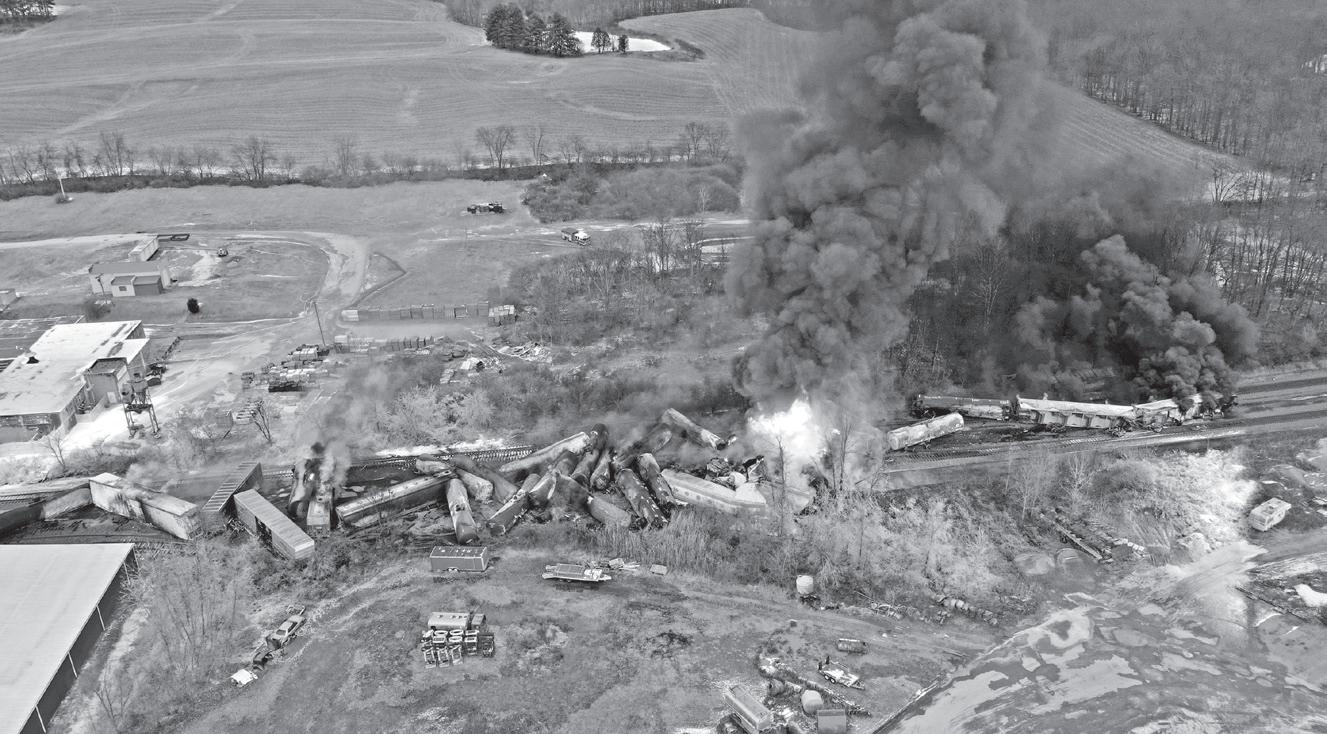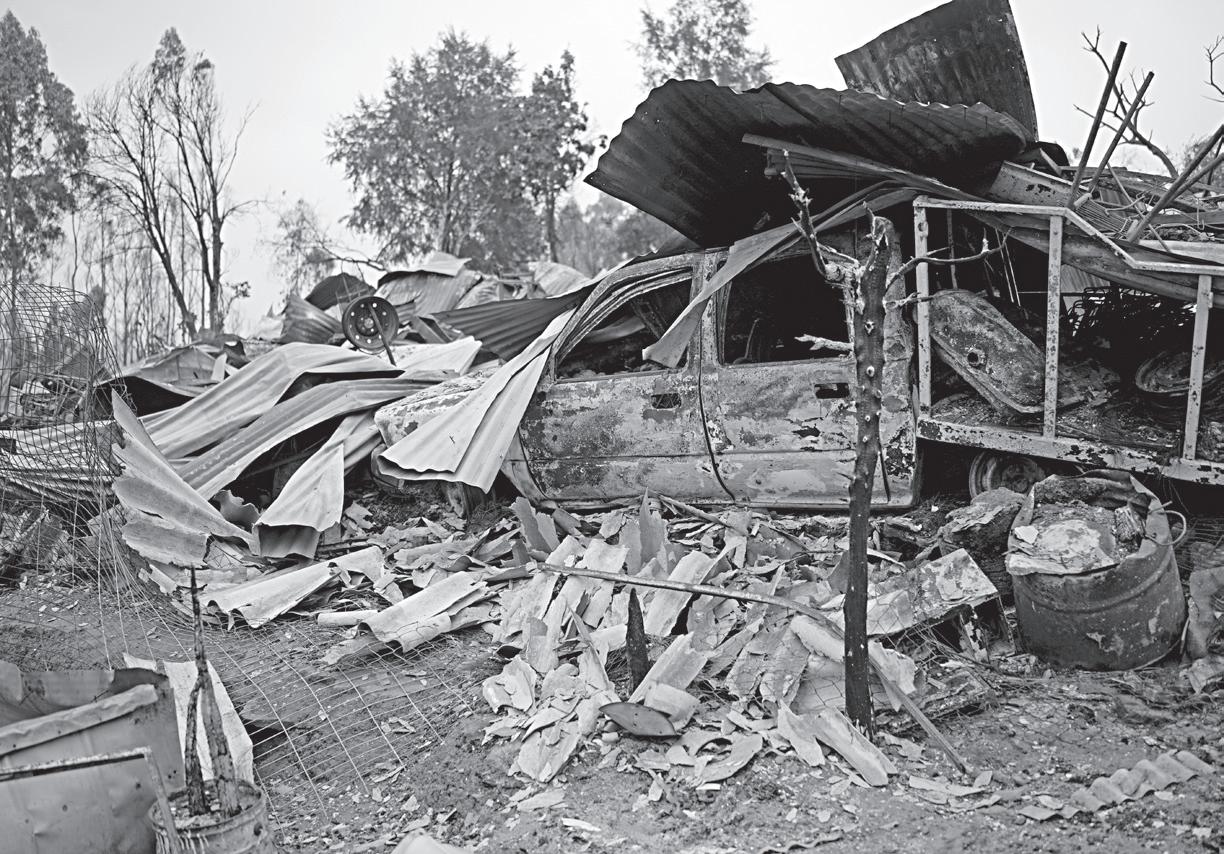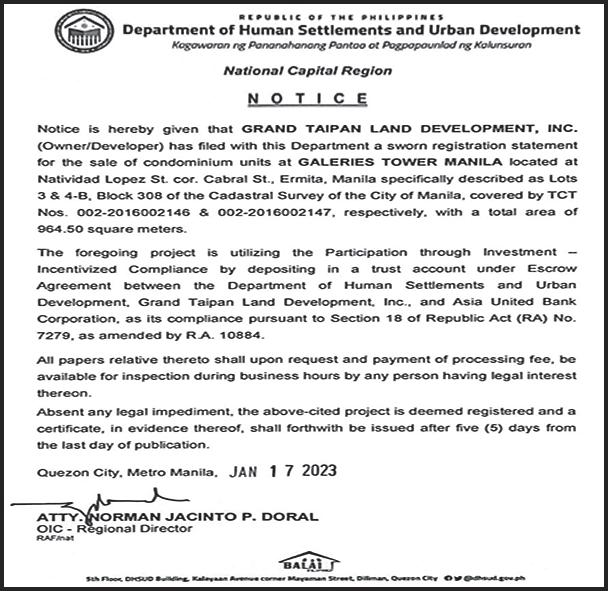
5 minute read
50-car train derailment causes big fire, evacuations in Ohio
EAST PALESTINE, Ohio—A freight train derailment in Ohio near the Pennsylvania state line left a mangled and charred mass of boxcars and flames Saturday as authorities launched a federal investigation and monitored air quality from the various hazardous chemicals in the train.
About 50 cars derailed in East Palestine at about 9 p.m. EST Friday as a train was carrying a variety of products from Madison, Illinois, to Conway, Pennsylvania, rail operator Norfolk Southern said Saturday. There was no immediate information about what caused the derailment. No injuries or damage to structures were reported.
“The post-derailment fire spanned about the length of the derailed train cars,” Michael Graham, a member of the National Transportation Safety Board, told reporters Saturday evening. “The fire has since reduced in intensity, but remains active and the two main tracks are still blocked.”
Norfolk Southern said 20 of the more than 100 cars were classified as carrying hazardous materials— defined as cargo that could pose any kind of danger “including flammables, combustibles, or environmental risks.” Graham said 14 cars carrying vinyl chloride were involved in the derailment “and have been exposed to fire,” and at least one “is intermittently releasing the contents of the car through a pressure release device as designed.”
“At this time we are working to verify which hazardous materials cars, if any, have been breached,” he said. The Environmental Protection Agency and Norfolk Southern were continuing to monitor air quality, and investigators would begin their on-scene work “once the scene is safe and secure,” he said.
Vinyl chloride, used to make the polyvinyl chloride hard plastic resin used in a variety of plastic products, is associated with increased risk of liver cancer and other cancers, according to the federal government’s National Cancer Institute. Federal officials said they were also concerned about other possibly hazardous materials.
Mayor Trent Conaway, who earlier declared a state of emergency citing the “train derailment with hazardous materials,” said air quality monitors throughout a one-mile zone ordered evacuated had shown no dangerous readings.
Fire Chief Keith Drabick said officials were most concerned about the vinyl chloride and referenced one car containing that chemical but said safety features on that car were still functioning. Emergency crews would keep their distance until Norfolk Southern officials told them it was safe to approach, Drabick said.
“When they say it’s time to go in and put the fire out, my guys will go in and put the fire out,” he said. He said there were also other chemicals in the cars and officials would seek a list from Norfolk Southern and federal authorities.
Graham said the safety board’s team would concentrate on gathering “perishable” information about the derailment of the train, which had 141 load cars, nine empty cars and three locomotives. State police had aerial footage and the locomotives had forward-facing image recorders as well as data recorders that could provide such information as train speed, throttle position and brake applications, he said. Train crew and other witnesses would also be interviewed, Graham said.
Firefighters were pulled from the immediate area and unmanned streams were used to protect some areas including businesses that might also have contained materials of concern, officials said. Freezing temperatures in the single digits complicated the response as trucks pumping water froze, Conaway said.
East Palestine officials said 68 agencies from three states and a number of counties responded to the derailment, which happened about 51 miles (82 kilometers) northwest of Pittsburgh and within 20 miles (32 kilometers) of the tip of West Virginia’s Northern Panhandle.
Conaway said surveillance from the air showed “an entanglement of cars” with fires still burning and heavy smoke continuing to billow from the scene as officials tried to determine what was in each car from the labels outside. The evacuation order and shelter-in-place warnings would remain in effect until further notice, officials said.
Village officials warned residents that they might hear explosions due to the fire. They said drinking water was safe despite discoloration due to the volume being pumped the fight the blaze. Some runoff had been detected in streams but rail officials were working to stem that and prevent it from going downstream, officials said.
Officials repeatedly urged people not to come to the scene, saying they were endangering not only themselves but also emergency responders.
The evacuation area covered 1,500 to 2,000 of the town’s 4,800 to 4,900 residents, but it was unknown how many were actually affected, Conaway said. A high school and community center were opened, and the few dozen residents sheltering at the high school included Ann McAnlis, who said a neighbor had texted her about the crash.

“She took a picture of the glow in the sky from the front porch,” McAnlis told WFMJ-TV. “That’s when I knew how substantial this was.”
Norfolk Southern opened an assistance center in the village to take information from affected residents and also said it was “supporting the efforts of the American Red Cross and their temporary community shelters through a $25,000 donation.
Elizabeth Parker Sherry said her 19-year-old son was heading to Walmart to pick up a new TV in time for the Super Bowl when he called her outside to see the flames and black smoke billowing toward their home. She said she messaged her mother to get out of her home next to the tracks, but all three of them and her daughter then had to leave her own home as crews went door-to-door to tell people to leave the evacuation zone. AP
SANTIAGO, Chile—Chile extended an emergency declaration to yet another region on Saturday as firefighters struggled to control dozens of raging wildfires that have claimed at least 22 lives amid a scorching heat wave that has broken records.
The government declared a state of catastrophe in the La Araucanía region, which is south of Ñuble and Biobío, two central-southern regions where the emergency declaration had already been issued. The measure allows for greater cooperation with the military.

At least 22 people have died in connection to the fires and 554 have been injured, including 16 in serious condition, according to Interior Minister Carolina Tohá. The death toll is likely to rise as Tohá said there are unconfirmed reports of at least 10 people missing.
Sixteen of the deaths took place in Biobío, five in La Araucanía and one in Ñuble.
The deaths included a Bolivian pilot who died when a helicopter that was helping combat the flames crashed in La Araucanía. A Chilean mechanic also died in the crash.
Over the past week, fires have burned through an area equivalent to what is usually burned in an entire year, Tohá said in a news conference.
The fires come at a time of record high temperatures.
“The thermometer has reached points that we have never known until now,” Tohá said.
As of Saturday morning, there were 251 wildfires raging throughout Chile, 151 of which were under control, according to Chile’s Senapred disaster agency.
“Seventy-six new fires appeared yesterday,” Tohá said Saturday.
The minister also suggested the fires should serve as yet another wake up call about the effects of climate change.
“The evolution of climate change shows us again and again that this has a centrality and a capacity to cause an impact that we have to internalize much more,” Tohá said. “Chile is one of the countries with the highest vulnerability to climate change, and this isn’t theory but rather practical experience.”
Chile is requesting international cooperation to assist the firefighting efforts.
“We’re requesting support from several countries to address the emergency,” President Gabriel Boric wrote on social media. AP








